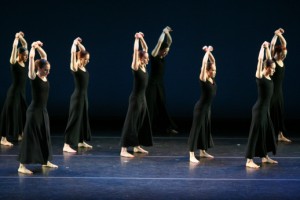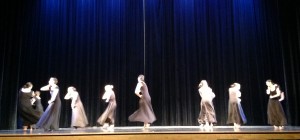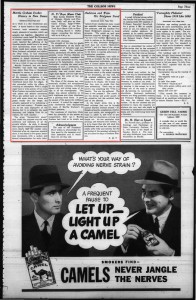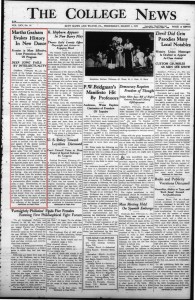
Bryn Mawr’s Modern Ensemble gets steppin’
(Photo by Tiannan Zhan, BMC ’14)
Everyone involved in this early stage of the Mawr Steps reconstruction process came together for an inaugural 3 hours this past Friday evening. Though I have studied dance and performed original (or derivative) works, this is my first time working with a reconstruction. I am now struck by the imbalance in my dance education between the study of history (non-existent) and technique. I don’t think this is unique to my early pedagogical experience (my formal dance training essentially ended when I turned 16) but understanding this discrepancy does lend new significance to the concept of stepping into dance history for me.
A “Martha Graham Tool Kit” has been provided by the Graham Company as part of the artistic support they will be lending to Bryn Mawr’s licensed reconstruction of Steps in the Street. This kit includes, in addition to rehearsal videos and audio, what I have termed the reconstruction bible (I mean, binder…) This binder, which the Dance Program may hold onto until the April performances, has in it:
- historic background of Steps in the Street
- press clippings referencing Steps
- Martha Graham quotes and biographical info.
- template for the programs distributed at a student production
- technical instructions – for staging, lighting & costume design
- archival images of Steps being performed by Graham Company dancers
Jennifer Conley introduced Bryn Mawr’s student dancers (and us documentarians) to the work they would be reconstructing by encouraging active engagement with these materials. We flipped through pictures together, analyzing Graham Company images at Jennifer’s prompting – identifying formal elements and thinking about their emotional or intellectual implications. And through this exercise we came to understand the history, content and choreography of the work as well.

Martha Graham Dance Company in Martha Graham’s “Sketches from ‘Chronicle'”
(Photo by Costas / Copyright Costas)
In this image, “the strike,” for instance: the women’s angular, sharp elbows and firmly planted feet indicate strength; the arms crossed over their heads express both resistance and empowerment; the mass structure demonstrates unity but not conformity – an opposition both psychic and corporeal.
Even though I will not be stepping through time on stage in April, the way I began to relate to history during Friday’s rehearsal awakened in me an anticipatory reverence for, and an embodied awareness of, what great value lies in sharing this movement legacy.





